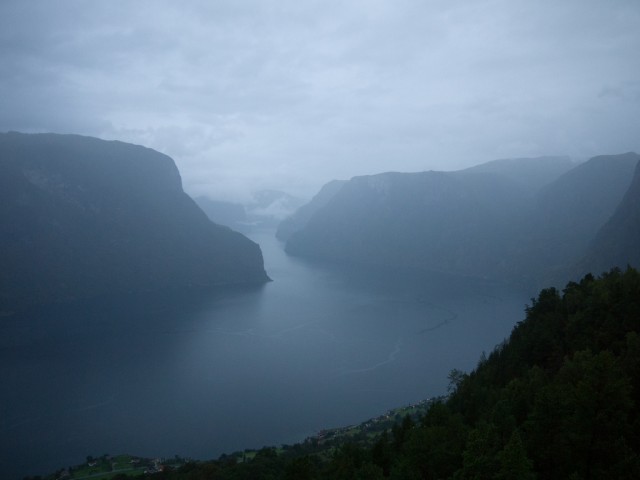Japanese earthquake literally made waves in Norway
 During an earthquake, it’s the area near the epicenter that sustains the greatest damage, though shaking can sometimes be perceptible at impressive distances. But the seismic energy released by the earthquake actually travels around the globe—several times, in fact—as the planet, in essence, rings like a struck bell. The bigger the earthquake, the louder it rings. And the magnitude 9.0 quake that struck just off the coast of Japan on March 11, 2011 was very big, indeed.
During an earthquake, it’s the area near the epicenter that sustains the greatest damage, though shaking can sometimes be perceptible at impressive distances. But the seismic energy released by the earthquake actually travels around the globe—several times, in fact—as the planet, in essence, rings like a struck bell. The bigger the earthquake, the louder it rings. And the magnitude 9.0 quake that struck just off the coast of Japan on March 11, 2011 was very big, indeed.
Scientific instruments like seismometers are sensitive enough to pick up seismic waves from distant earthquakes, even on their second or third trip around the planet. (Satellites have even detected the accompanying atmospheric waves.) It doesn’t always take super-precise measurements to know something is happening, however. A groundwater monitoring well in Virginia made the passage of seismic waves from the 2011 Tohoku earthquake quite clear in the form of a rapid two foot rise in water level.
While the tsunami that accompanied the earthquake in Japan was devastating, waves of a very different sort were spawned far away—in the fjords of Norway. A number of witnesses noticed the strange waves, occurring as they did on a calm morning when the fjord waters were otherwise smooth. As some managed to capture on video, the water swelled and ebbed by as much as five feet once per minute or so for several hours—starting about half an hour after the earthquake in Japan.
Long, slow waves of this sort in liquids are known as “seiches,” and they can occur for a number of reasons on enclosed (or partly enclosed) bodies of water. They’re commonly caused by winds pushing water to one side of the lake or bay but can also be induced by earthquake shaking. In that case, the seiches are similar to a sloshing tub of water. In this case the tubs were fjords—steep-sided but broad valleys carved by glaciers that were subsequently flooded by rising seas.
To investigate how the Tohoku earthquake made this happen, a group of Norwegian researchers used a computer model built to simulate tides and storm surges along the coast. They input the shaking measured at a nearby seismometer and compared the model’s results to the videos and eyewitness reports of the seiches. The model matched observations quite well, allowing them to investigate precisely what triggered the waves.
Seismic energy travels away from the location of an earthquake in two ways: radially through the body of the Earth, or laterally, skimming along the surface. The body waves move more quickly, but the surface waves can cause more violent shaking, especially in areas far from the epicenter. Consequently, it’s normally surface waves that cause seiches.
In the case of the fjords, however, it was one of the body waves—what are known as “S-waves." The shaking motion of an S-wave is perpendicular to the direction the wave is traveling. If you hold one end of a rope tied to a wall and flick your wrist, sending a wave down to the other end, you’ll have made an S-wave. The model revealed that it was this side-to-side horizontal shaking that started the fjord water sloshing, though similar shaking from surface waves did amplify the action a bit. This was actually apparent from the observations as well, as the seiches noticeably appeared after the S-waves arrived but before the surface waves hit the scene several minutes later.
If the S-waves cause less shaking, why should they be responsible for the seiches in this case? It comes down to frequency. The S-waves were shaking at a lower frequency in sync with the amount of time it took for waves to travel across the fjord—resonating, essentially.
Earthquake-linked seiches are not unknown in the region, having been noted in 1755, 1920, and 1950. But why do they occur with some earthquakes and not others? It’s not just magnitude—after all, 2010 saw a magnitude 8.8 earthquake in Chile without videos of waves. The researchers turned to their model to find out.
Simulating shaking from the Chile earthquake produced no seiches in the model. The difference relates to the properties of the seismic waves and the location of the earthquake. The low frequency, side-to-side component of shaking from the Chile earthquake happened to be weaker. Obviously, the seismic waves traveling from Chile came from a different direction than those from Japan. Critically, the seismic waves from Japan happened to be traveling roughly down the length of these fjords, meaning that the side-to-side shaking was oriented across the fjord. The seismic waves from Chile just weren’t lined up right to start the fjords a-sloshing.
On that morning in March of 2011, shaking in just the right direction and at the right frequency was supplied by a deadly event some 5,000 miles away. For some who lived along the fjords, the strange waves probably reached them before news of the disaster in Japan. ARSTechnica
